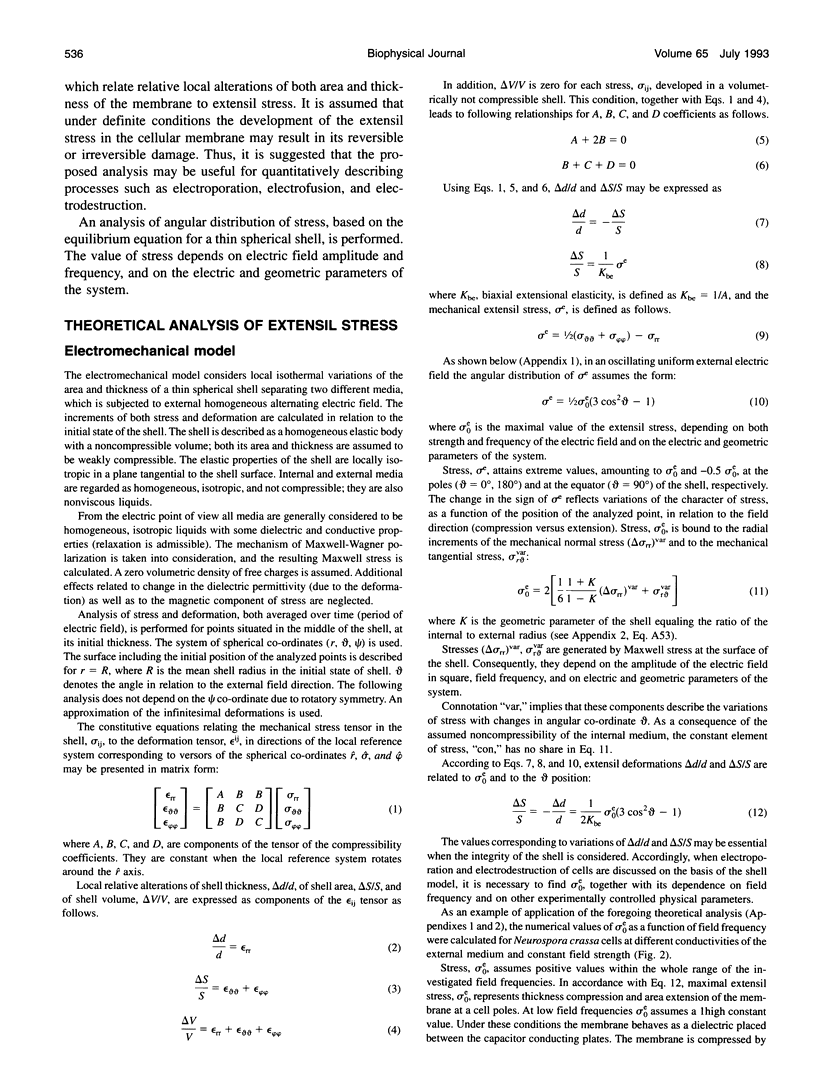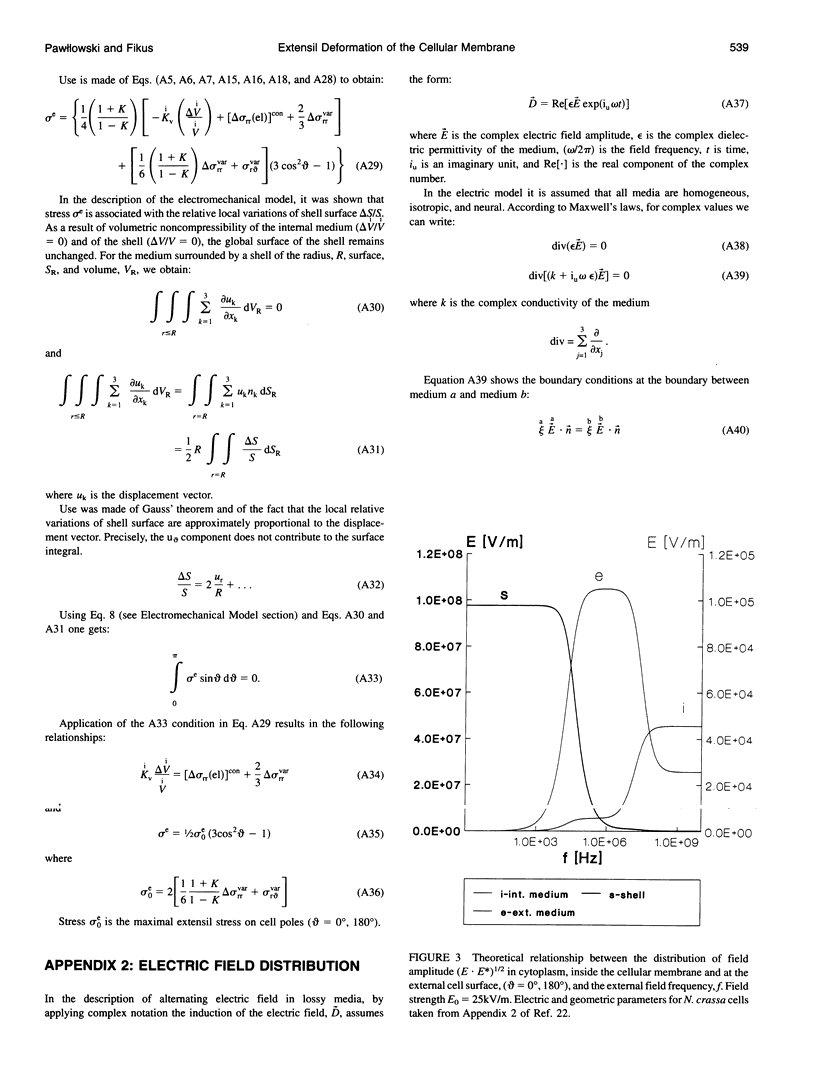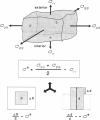Abstract
Analysis of the angular distribution of extensil mechanical stress, sigma e, generated in cytoplasmic membranes by an external oscillating electric field, is presented. Theoretical considerations show that sigma e is directly proportional to the local relative increase in membrane area and/or to the local relative decrease in its thickness. The magnitude of this stress depends on the position of the analyzed point of the membrane in relation to field direction. The maximal value, sigma eo, is reached at the cell "poles." The magnitude of sigma eo depends on electric and geometric parameters (in particular on field frequency) of the system studied. The foregoing analysis can be applied to quantitatively describe the destabilizing effects of the electric field on the cellular membrane, leading to its poration, fusion, and destruction.
Full text
PDF





Images in this article
Selected References
These references are in PubMed. This may not be the complete list of references from this article.
- Chang D. C. Cell poration and cell fusion using an oscillating electric field. Biophys J. 1989 Oct;56(4):641–652. doi: 10.1016/S0006-3495(89)82711-0. [DOI] [PMC free article] [PubMed] [Google Scholar]
- Crowley J. M. Electrical breakdown of bimolecular lipid membranes as an electromechanical instability. Biophys J. 1973 Jul;13(7):711–724. doi: 10.1016/S0006-3495(73)86017-5. [DOI] [PMC free article] [PubMed] [Google Scholar]
- Fikus M., Pawlowski P. Bioelectrorheological model of the cell. 2. Analysis of creep and its experimental verification. J Theor Biol. 1989 Apr 20;137(4):365–373. doi: 10.1016/s0022-5193(89)80035-9. [DOI] [PubMed] [Google Scholar]
- Kinosita K., Jr, Tsong T. Y. Formation and resealing of pores of controlled sizes in human erythrocyte membrane. Nature. 1977 Aug 4;268(5619):438–441. doi: 10.1038/268438a0. [DOI] [PubMed] [Google Scholar]
- Needham D., Hochmuth R. M. Electro-mechanical permeabilization of lipid vesicles. Role of membrane tension and compressibility. Biophys J. 1989 May;55(5):1001–1009. doi: 10.1016/S0006-3495(89)82898-X. [DOI] [PMC free article] [PubMed] [Google Scholar]
- Neumann E., Rosenheck K. Permeability changes induced by electric impulses in vesicular membranes. J Membr Biol. 1972 Dec 29;10(3):279–290. doi: 10.1007/BF01867861. [DOI] [PubMed] [Google Scholar]
- Neumann E., Schaefer-Ridder M., Wang Y., Hofschneider P. H. Gene transfer into mouse lyoma cells by electroporation in high electric fields. EMBO J. 1982;1(7):841–845. doi: 10.1002/j.1460-2075.1982.tb01257.x. [DOI] [PMC free article] [PubMed] [Google Scholar]
- Pawlowski P., Fikus M. Bioelectrorheological model of the cell. 1. Analysis of stresses and deformations. J Theor Biol. 1989 Apr 6;137(3):321–337. doi: 10.1016/s0022-5193(89)80075-x. [DOI] [PubMed] [Google Scholar]
- Poznański J., Pawłowski P., Fikus M. Bioelectrorheological model of the cell. 3. Viscoelastic shear deformation of the membrane. Biophys J. 1992 Mar;61(3):612–620. doi: 10.1016/S0006-3495(92)81866-0. [DOI] [PMC free article] [PubMed] [Google Scholar]
- Sale A. J., Hamilton W. A. Effects of high electric fields on micro-organisms. 3. Lysis of erythrocytes and protoplasts. Biochim Biophys Acta. 1968 Aug;163(1):37–43. doi: 10.1016/0005-2736(68)90030-8. [DOI] [PubMed] [Google Scholar]
- Schwister K., Deuticke B. Formation and properties of aqueous leaks induced in human erythrocytes by electrical breakdown. Biochim Biophys Acta. 1985 Jun 27;816(2):332–348. doi: 10.1016/0005-2736(85)90501-2. [DOI] [PubMed] [Google Scholar]
- Sowers A. E. Characterization of electric field-induced fusion in erythrocyte ghost membranes. J Cell Biol. 1984 Dec;99(6):1989–1996. doi: 10.1083/jcb.99.6.1989. [DOI] [PMC free article] [PubMed] [Google Scholar]
- Sugar I. P., Neumann E. Stochastic model for electric field-induced membrane pores. Electroporation. Biophys Chem. 1984 May;19(3):211–225. doi: 10.1016/0301-4622(84)87003-9. [DOI] [PubMed] [Google Scholar]
- Winterhalter M, Helfrich W. Effect of voltage on pores in membranes. Phys Rev A Gen Phys. 1987 Dec 15;36(12):5874–5876. doi: 10.1103/physreva.36.5874. [DOI] [PubMed] [Google Scholar]
- Zimmermann U., Beckers F., Coster H. G. The effect of pressure on the electrical breakdown in the membranes of Valonia utricularis. Biochim Biophys Acta. 1977 Jan 21;464(2):399–346. doi: 10.1016/0005-2736(77)90014-1. [DOI] [PubMed] [Google Scholar]
- Zimmermann U., Pilwat G., Péqueux A., Gilles R. Electro-mechanical properties of human erythrocyte membranes: the pressure-dependence of potassium permeability. J Membr Biol. 1980 May 23;54(2):103–113. doi: 10.1007/BF01940564. [DOI] [PubMed] [Google Scholar]



